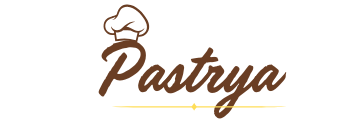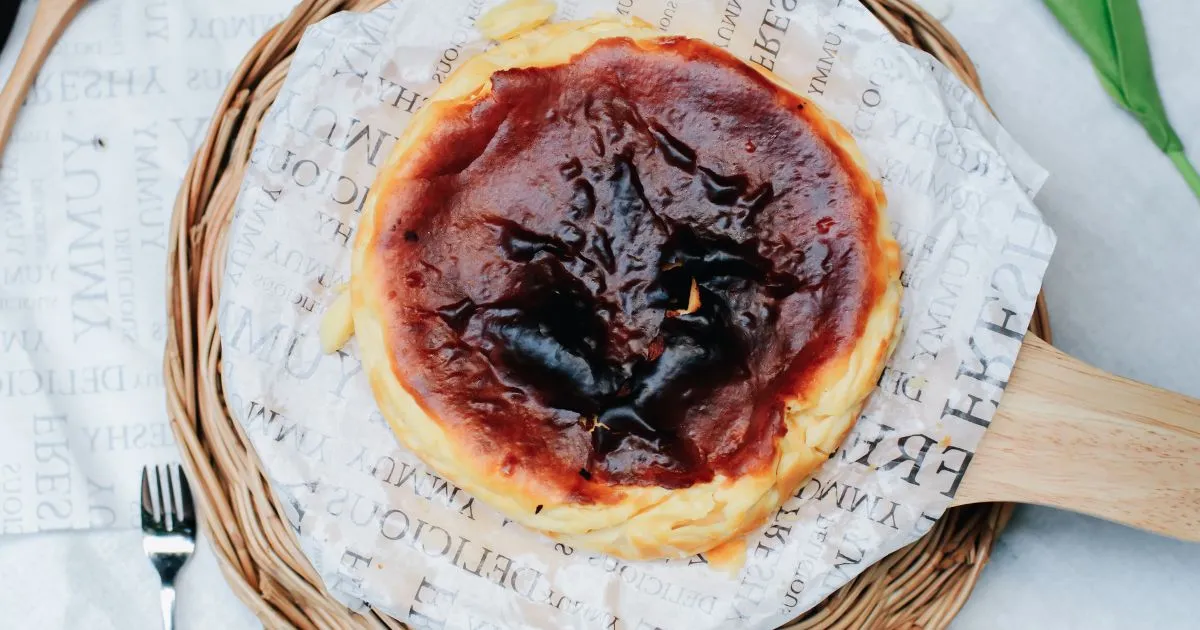The Burnt Cheesecake
A dessert with a crackled, caramelized crust and a velvety, almost molten center, beautifully swirled with silky dulce de leche. Burnt cheesecake is more than just a treat—it’s a bold combination of textures and flavors that captivates with every bite.
Beneath its smoky, darkened top lies a rich, custard-like core that sets it apart from classic cheesecakes. The contrast between the slightly bitter crust and the sweet, creamy dulce de leche creates a unique and irresistible balance.
Table of Contents
Key Takeaways
- Burnt cheesecake combines a crispy top with a creamy, almost runny core.
- Dulce de leche swirl adds a layer of caramel-like sweetness.
- Its unique baking method creates a distinctive caramelized crust.
- Simple ingredients yield an elegant, restaurant-quality dessert.
- Proper technique ensures the right balance between burnt edges and soft center.
A Delicious Journey into Basque Cheesecake
Discover the story of Basque Cheesecake, a modern dessert loved by chefs and home bakers. It started in the Basque Country, between Spain and France. Now, it’s a favorite in kitchens everywhere, thanks to its unique taste and texture.
History and Origins
The Basque Country is where this cheesecake comes from. It was born from old farmhouse recipes. Baked in rustic ovens, it got its charred crust and creamy inside.
Today, this easy recipe keeps its roots alive while fitting into today’s kitchens.
What Sets It Apart
Basque Cheesecake is special because of its extremes. It has a burnt top and a smooth inside. Here’s how it compares to traditional cheesecakes:
| Feature | Basque Cheesecake | Classic Cheesecake |
| Texture | Caramelized top + creamy core | Smoother, uniform texture |
| Baking Method | High-heat water bath | Low-and-slow baking |
| Signature Element | Distinctive charred rim | Silky, even consistency |
Its bold flavors and look make it unique. But the easy recipe makes it simple to make. It’s perfect for beginners and experts alike, turning every try into a success.
Mastering the Art of Burnt Cheesecake
Creating a perfect burnt Basque cheesecake is all about mastering the basics. Every ingredient and step is crucial for that iconic crackled top and creamy center. Let’s explore the details that make a simple recipe into a gourmet delight.
Essential Ingredients
Quality ingredients are key to success. Here are the must-haves:
- Cream cheese: Choose full-fat blocks, not spreadable types.
- Sugar: Combine granulated and brown sugar for a richer caramelized flavor.
- Eggs: Make sure they’re at room temperature for smooth mixing.
- Vanilla: Pure extract adds a rich, homemade taste.
“A cheesecake’s soul is in its ingredients—never compromise here,” says a top pastry chef.
Baking Techniques for Perfection
Here are the essential steps for perfection:
- Preheat to 500°F (260°C) for quick caramelization.
- Tightly wrap your springform pan with foil to prepare it for a water bath.
- Bake for 50–60 minutes, until the edges are firm and the center still has a slight wobble.
- Cool slowly in the oven to prevent cracking.
Homemade baking is all about precision. Pay attention to oven placement and test doneness with a knife. Every tweak is important to get the cake’s creamy inside and burnt outside just right.
Easy Steps to a Creamy Texture Delight
Making a silky center in burnt Basque cheesecake is all about following the right steps. These steps help you get that creamy texture easily. You don’t need to make it complicated.
- Mix ingredients at room temperature: Cold ingredients like cream cheese or sour cream can form lumps. This disrupts the smooth creamy texture. Let them sit at room temperature for 30 minutes before mixing.
- Blend thoroughly but gently: Use a hand mixer on medium speed for 2-3 minutes. Overmixing introduces air, while undermixing leaves unblended ingredients. Aim for a glossy, homogeneous batter.
- Bake in a water bath: Place your springform pan in a roasting pan filled with hot water. The steam creates a humid environment. This prevents dryness and keeps the creamy texture during baking.
- Cool slowly: Turn off the oven and let the cheesecake rest inside for an hour. Rapid cooling causes cracks. This can ruin the delicate interior consistency.
Using quality ingredients like Philadelphia Cream Cheese and heavy cream is crucial. For an extra silky result, add ¼ teaspoon of xanthan gum. It stabilizes the mixture without altering taste. Avoid substitutions like low-fat dairy, as they compromise the richness and texture.
Tips for Achieving a Caramelized Top and Rich Flavor
To get the perfect caramelized crust and rich flavor, focus on two main things: oven management and timing. These steps help the outside get a deep, golden glaze. Meanwhile, the inside stays creamy and luxurious.
Temperature Control and Oven Settings
- Preheat your oven to 425°F (220°C) for 15 minutes before baking. A preheated oven keeps the heat steady, which is key for even caramelization.
- Put the rack in the oven’s center. If your oven is not even, turn the pan halfway through to avoid scorching one side.
- Don’t open the oven door until the last 5 minutes. Changing the temperature too often can mess up the caramelization.
Timing Your Bake Just Right
Keep an eye out for these signs to get the perfect texture and color:
- Bake for 55–65 minutes total. The edges should crack and brown, but the center should still be a bit jiggly.
- Turn on the broiler for 1–2 minutes at the end if the top isn’t brown enough. Watch it closely to avoid burning.
- Let the dessert cool in the oven with the door ajar. This slow cooling helps prevent it from sinking.
Decadent Dulce de Leche Swirls: Elevating Your Dessert
Adding dulce de leche swirls takes your baking to a new level. These luscious ribbons of caramelized milk add a visual and taste contrast to the rich cheesecake base. Start by drizzling store-bought or homemade dulce de leche over the batter in a zigzag pattern before baking.
- Use a knife or skewer to gently swirl the caramel into the batter without overmixing.
- Experiment with patterns—try spirals for elegance or random lines for a rustic look.
- Ensure the dulce de leche is at room temperature to blend smoothly.
| Swirl Technique | Pros | Cons |
| Zigzag Drizzle | Easy to execute | Less dramatic visual impact |
| Spiral Twist | Attractive presentation | Requires steady hand |
| Marbled Layer | Even caramel distribution | Risk of overmixing |
“The swirl isn’t just an addition—it’s the star of the show.” – *Master Baker’s Guide to Showstopping Desserts* (2023)
Pair this technique with precise baking temperatures from earlier steps to lock in the caramel’s nutty sweetness. Over-swirling can dilute the flavor, so practice on a small batter portion first. The result? A dessert that dazzles guests and delivers layers of flavor in every bite.
Homemade Baking Made Simple with Simple Ingredients
Learning to make this dessert is all about the basics. It’s about making sure every bite is full of rich flavor but easy to make. Even if you’re new to baking, you can still make it taste like a pro’s.
Accurate Measurements for Consistency
- Use a digital scale for cream cheese and sugar to avoid over-or under-measuring.
- Sift flour and cocoa powder before mixing to eliminate lumps and ensure smooth texture.
- Bring all ingredients to room temperature—this helps blend ingredients evenly, amplifying the rich flavor.
Ingredient Substitutions and Enhancements
Try different ingredients to fit your diet or taste. This way, you can keep that special taste:
- Swap regular sugar for dark brown sugar to deepen the caramel notes.
- Replace ¼ of the cream cheese with mascarpone for silkiness without losing structure.
- Add a pinch of sea salt to balance sweetness and enhance the rich flavor.
Pro tip: A half-ounce of instant espresso powder can heighten chocolate undertones without bitterness.
Baking Secrets for a Rich and Decadent Dessert Experience
Turn your burnt Basque cheesecake into a stunning dessert with these tips. Small changes in the end can make a big difference. They ensure every bite is a luxury.
Ensuring Uniform Bake
A perfect bake needs precision. Follow these steps to avoid cracks and uneven cooking:
- Water Bath: Put your springform pan in a roasting pan with hot water. This keeps the heat steady and prevents cracking.
- Oven Placement: Place the pan in the middle rack. Stay away from the edges where air moves too much.
- Rotate the Pan: Turn the pan 180 degrees halfway through baking. This ensures even browning and prevents overcooking in corners.
Perfecting the Finishing Touch
A final touch makes the cake truly special. Here are some presentation ideas:
| Element | Option 1 | Option 2 |
| Texture Contrast | Top with crushed pistachios before baking | Add a layer of fresh raspberries post-chilling |
| Serving Garnish | Sprinkle flaky sea salt over caramelized top | Pair with a drizzle of white chocolate |
Let the cake cool in its pan for 10 minutes before chilling. Serve chilled for a silky center and a decadent crust. The best desserts combine skill and creativity.
Conclusion
Blending ingredients and perfecting the caramelized crust shows how simple things can be amazing. This recipe turns basic items into a favorite dessert for many in the U.S. Every step, from oven tests to swirl techniques, boosts your kitchen confidence.
Learning to make burnt Basque cheesecake is about understanding temperature and timing. Even small changes, like using lemon zest instead of vanilla, can make it your own. It shows that great taste comes from being precise, not from using a lot of ingredients.
Now you can try different dulce de leche patterns or adjust baking times. Share your cheesecake with friends and track your progress. Remember, even experts started small. Your kitchen is waiting to surprise you—so get ready to mix and let the cheesecake’s layers shine.
FAQ
What is a burnt cheesecake?
A burnt cheesecake, also known as Basque cheesecake, has a caramelized top. It’s creamy inside and rich in flavor. The burnt outside looks unique but the inside stays smooth.
How can I achieve a creamy texture in my burnt cheesecake?
For a creamy texture, use top-quality cream cheese. Make sure all ingredients are room temperature. Follow the recipe closely for the best results.
What are the essential ingredients for making burnt cheesecake?
You’ll need cream cheese, sugar, eggs, heavy cream, and flour. These ingredients make the cheesecake rich and creamy.
Can I add variations to my burnt cheesecake, like dulce de leche swirls?
Yes! Adding dulce de leche swirls brings a caramel flavor. Just mix it into the batter before baking for a tasty surprise.
What baking techniques should I use for perfection?
Use the right temperature and timing. Bake in a water bath for even heat. Check it a few minutes early to avoid overcooking.
Is this dessert suitable for beginners?
Yes, it’s a simple recipe for beginners. It has easy steps and basic ingredients, making it perfect for new bakers.
How do I ensure my burnt cheesecake has a caramelized top?
For a caramelized top, bake at a high temperature. Watch it closely in the last few minutes to get the right color without burning.
How can I adapt the recipe for dietary restrictions?
You can swap ingredients for dietary needs. Try dairy-free cream cheese or coconut cream for gluten-free. Just keep the texture and flavor right.

